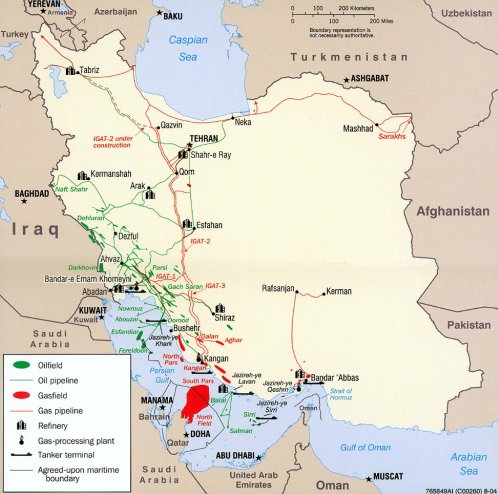

|
| weblog/wEssays archives | home | |
|
Vulnerability, or, Thinking About the Unthinkable (January 30, 2007) The President of Iran has made no secret of his desire to destroy Israel, a small nation which zealots gloatingly describe as a "one-bomb state," meaning that one nuclear bomb would wipe the country from the map. But perhaps the Iranian zealots should take a close look at a map of their own nation before they gloat too much. For one glance reveals that theirs is about a "ten-bomb state" facing an opponent (Israel) with an estimated 25 to 50 nuclear-armed missiles. 
As we discussed yesterday, systems in which key components or assets are highly concentrated are inherently brittle, or vulnerable. As we peer into the dark globe that is nuclear war, we should recall that many people thought very deeply about the issues of vulnerability, targeting and survivability during the Cold War between the U.S. and the U.S.S.R. For starters, I would recommend a classic of that literature, Thinking about the Unthinkable Though it is widely assumed a nuclear war means the end of a nation, even one as large as the U.S., it is not strictly true. The level of destruction depends of course on the number of weapons deployed, but it is heavily dependent on the diffusion /concentration of a nation's assets. A comparison of the U.S. and U.S.S.R.'s brittleness and resiliency--a comparison of the concentration and therefore vulnerability of key assets--reveals that the Soviet Union was far more vulnerable to a nuclear attack than the U.S. for the simple reason that the majority of its human and physical capital are centered in Moscow. With few ports and rail centers, and much of its energy and military complex in tight concentrations, a "limited strike" of perhaps 100 weapons would have destroyed virtually the entire core of Soviet power while leaving most of its people unaffected. The political, transportation, energy, military and human capital of the U.S. is more widely distributed, and so even though a 100-weapon strike would have devastating consequences, to say that the U.S. would be utterly destroyed would simply not be true. There would be roads, railways, ports, energy assets, intellectual capital, and political structures which would survive a 100-bomb strike. Now I want to stress here that I am not underplaying the effects of nuclear weapons, or advocating their use. I am simply pointing out that states in which the capital city contains the vast majority of the nation's political and intellectual capital, as well as much of the industry, expertise, transportation and energy facilities, are far more vulnerable to nuclear attack than nations with widely dispersed assets. Even a cursory look at Iran reveals that the majority of that nation's human and physical capital is in Tehran, and much of the nation's primary asset--oil--is concentrated in a handful of fields and transported in a handful of pipelines. Most of the country is a desert wasteland; once its capital were leveled and its oil facilities destroyed with ground-burst nuclear weapons, there would be few resources or assets left to work with. My point is simply that a "ten-bomb state" with highly concentrated assets had better be careful toying with a "one-bomb state" with 25-50 deliverable warheads. The Israels would, after the first 20 or so weapons, be reduced to hitting secondary targets or "bouncing the rubble" in Tehran. There are also various levels of brittleness and vulnerability in weapons delivery systems. If your missiles are above ground or in visible (and therefore targetable) hardened silos, and you have a habit of boasting about your desire to deliver a nuke on said missiles, your enemy may decide to pre-emptively destroy your missiles with an air-burst nuclear weapon, frying its electronics, guidance and command-and-control systems, or destroying the silos with ground-burst nukes. The Israelis are also proported to maintain an undersea-launched (i.e. from a submarine) missile capability, one which is very hard to pre-emptively destroy. Which has the more resilient system? The "one-bomb state" with submarine-launched nuclear tipped missiles, or the "ten-bomb state" with vulnerable surface missiles? Just for comparison's sake: The U.S. maintains 18 "boomers" (Ohio-Class Fleet Ballistic Missile Submarines--SSBNs), each armed with 24 D-5 Trident missiles, which are each armed with 5 independently targetable warheads (MIRVs). Each U.S. SSBN thus carries 120 nuclear warheads, launched within one minute and deliverable anywhere in the world. That's 2,160 nuclear warheads distributed among 18 very-hard-to-locate boats. Not all are at sea at any one time, but catching a few in dock would still leave 1,500 or so nuclear weapons available for a counter-stike. What nation would chance absorbing even one SSBN's load of 120 nuclear bombs? That is resilence, which in the parlance of nuclear war translates to deterrence. It's a word which should be in everyone's vocabulary--even those ruling a "ten-bomb state." (Note: to comply with the Start II nuclear weapons reductions agreement with Russia, the U.S. will reduce its fleet of Ohio-class submarines from 18 to 14 in a few years.) But nuclear deterrence is not robust in all circumstances. As we have learned, it has little value against stateless terrorism--or even the state-sponsored variety. Just as a thought experiment: what if an anonymous nuclear bomb were to be trucked into the heart of Tehran and detonated? Yes, there are "signatures" to weapons--how "cleanly" they exploded--but what if a "clean" weapon were modified to be "dirty" enough to look amateurish? Then who would the President of Iran--were he still among the living--attack? The deterrence of nuclear bombs doesn't erase the threat of nuclear terrorism, it would seem, even for those states which sponsor conventional terrorism. For more on this subject and a wide array of other topics, please visit my weblog. copyright © 2007 Charles Hugh Smith. All rights reserved in all media. I would be honored if you linked this wEssay to your site, or printed a copy for your own use. |
||
| weblog/wEssays | home |